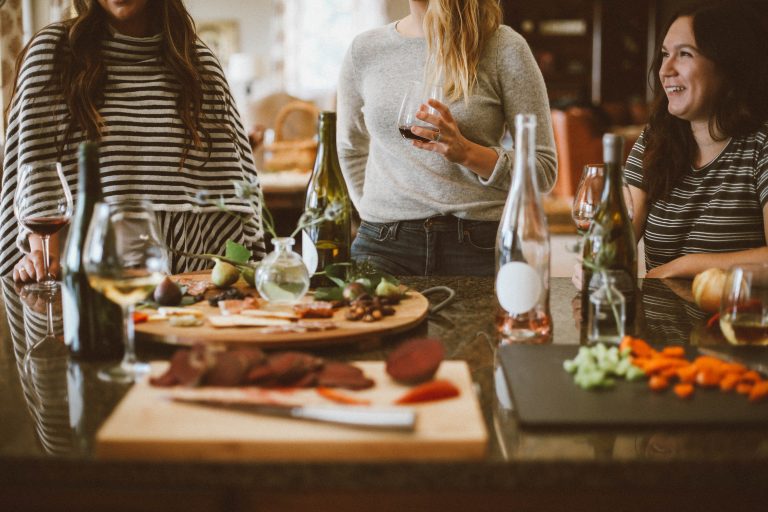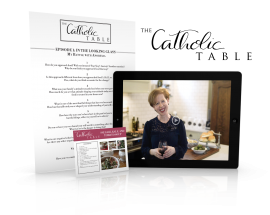By Emily Stimpson Chapman
Emily Stimpson Chapman is the award-winning author of several books and the host of the video study The Catholic Table.

The Church’s call to feast and the Church’s command to fast are, at least in my world, two of her greatest gifts. When done rightly and done well, feasting and fasting bring the whole person—body and soul—into the liturgical rhythms of the Church. They make the liturgical seasons incarnate in our homes and communities. They also help form communities, uniting rich and poor, young and old, married and single in a common practice: eating . . . or not eating as the case may be.
From the first months of my return to the Catholic faith I recognized this. It didn’t require a great deal of thinking or work on my part to see the value of feasting and fasting. But what did require thinking and work was doing it right.
I am a creature of extremes. I blame it on my red hair. My tendency, like many a ginger, is all or nothing. Balance, moderation, temperance—they don’t come naturally to me. My approach to fasting and feasting was no exception. Remember the Lent of the crashing, burning, vegan, Mormon celiac? That’s pure Emily.
Feasting was trickier still. There were just so many Feast Days. Was I supposed to eat cheesecake on all of them? If so, how much cheesecake? Was the Church cool with two pieces? What about three? Four definitely seemed like too much, but where did feasting end and gluttony begin? How did one draw the line?
I had similar queries about all the days in between the fasting and feasting—what the Church calls Ordinary Time. How, without my strict diet to guide me, was I supposed to navigate all the choices presented to me by our consumer culture? I wanted to appreciate the abundance of creation. I wanted to nourish my body and soul with God’s great gift of food. I just wasn’t sure how to find the right balance.
I didn’t find the solution to that dilemma overnight. There were no bolt-from-the-blue revelations in churches or bookstores. I just plowed ahead, sometimes eating too much, sometimes eating too little, but always trying to approach feasting, fasting, and ordinary eating with an eye to what God wanted from me in that particular moment. And slowly, gradually, I came to see that my trying was what God wanted from me. Eating itself offered me the opportunity to learn balance.
For years, I’d thought of eating as an opportunity for vice—for gluttony or greed. But what I failed to grasp is that eating is also an opportunity for virtue. It’s a daily invitation to flex our spiritual muscles and grow in justice, prudence, temperance, and fortitude. It’s also a chance to demonstrate faith, hope, and charity.
Our consumer culture doesn’t see eating this way. It wants to encourage the inner redhead in all of us and tempt us to extremes. Social media testifies to this in spades.
For example, come December, my various newsfeeds are glutted with pictures of savory sides and tasty treats. Recipes for peppermint shortbread cookies, hot buttered rum, and sausage-cranberry meatballs abound. Then, in January, it’s all “Whole 30 this” and “Paleo that.” The same phenomenon happens at Easter. One day, people are waxing rhapsodic about coconut raspberry scones; the next, everyone is condemning gluten like it’s the second coming of the Black Death.
Note: some people have legitimate problems with certain foods. I’m one of them. Peanuts make me stop breathing. It’s exceptionally annoying and often inconvenient. Food allergies and serious sensitivities always have my sympathy. But a good many of the people in my newsfeed who post close-ups of chocolate almond puff pastry one day and sing the praises of eating like cavemen the next struggle more with temperance than they do with dietary sensitivities.
I get the struggle. It’s mine too. We live in a culture of abundance, where bottomless baskets of breadsticks welcome us in every restaurant, 468 different kinds of breakfast cereal line the supermarket shelves, and thousands of food blogs tempt us daily with tasty treats.
That abundance has made some of us sick. It has made others among us a bit rounder than we’d like to be. Accordingly, the appeal of extreme diets, which promise good health and slim waistlines in exchange for eliminating whole categories of food, is understandable. Sometimes, the way of total abstinence just seems easier . . . and safer.
Which it may be. But it’s also rarely sustainable. Or enjoyable. That’s why diets almost always fail and why my Whole 30-loving friends are back to making cupcakes the day after their thirty days of “clean eating” end. Most of us don’t want to live in a world without donuts or pizza or dirty martinis. Nor, every time we eat outside our houses, do we want to be a total pain in the rear, demanding special treatment from friends hosting us for dinner or restaurants cooking us dinner.
This is why exercising virtue when we eat matters so much.
You Might Also Like

It’s unavoidable. We all must eat. But as Catholics, we know that how we eat matters as much as what we eat. In her book The Catholic Table, award-winning author Emily Stimpson Chapman explains how food is a sign of God’s love and a foretaste of the Eucharist.
Now, in The Catholic Table video series, you’ll discover what the Church teaches about creation, the body, feasting, fasting, the Eucharist—and so much more.